Tensile Properties of Cryorolled Cu/Al Clad Sheet with an SUS304 Interlayer after Annealing at Various Temperatures
Abstract
:1. Introduction
2. Materials and Methods
3. Results and Discussion
3.1. Microstructure Evolution of Cryorolled Samples during Annealing
3.2. Tensile Properties of Cryorolled and Hot-Rolled Samples
3.3. Effect of Cryorolling on Tensile Strength
3.4. Effect of Cryorolling on the Elongation after Fracture
4. Conclusions
- (1)
- Benefiting from the significant grain refinement effect of cryorolling, the tensile strength of the cryorolled samples reached as high as 302 MPa with the elongation after a fracture of 2.4%. After annealing, the proportion of recrystallized grains and substructured grains gradually increased. Upon annealing at 400 °C, the tensile strength decreased to 159 MPa, while the elongation recovered to 29.01%.
- (2)
- The ability of cryorolling to promote a higher proportion of LAGBs, coupled with the prevalence of numerous LAGBs within grains enhances the microstructural refinement, which is 35 MPa higher in tensile strength than that of the hot-rolled samples. A 13.1% increase is achieved within a total of 70% rolling reduction.
- (3)
- For samples annealed at 300 °C, the cryorolled samples exhibit a higher degree of recrystallization than the hot-rolled samples, resulting in an improved elongation after fracture. The strength comparable to the hot-rolled clad sheet is primarily attributed to the higher proportion of annealing twins.
Author Contributions
Funding
Institutional Review Board Statement
Informed Consent Statement
Data Availability Statement
Acknowledgments
Conflicts of Interest
References
- Han, J.C.; Li, S.; Gao, X.Y.; Huang, Z.Q.; Wang, T.; Huang, Q.X. Effect of annealing process on interface microstructure and mechanical property of the Cu/Al corrugated clad sheet. J. Mater. Res. Technol. 2023, 23, 284–299. [Google Scholar] [CrossRef]
- Xu, R.Z.; Li, F.S.; Yuan, C.C.; Zhang, Y.; Yan, W.D.; Zhao, X. Microstructure and phase constitution at the interface of double-sided electron beam welded Cu/Al clad metal sheet. Mater. Charact. 2021, 182, 111517. [Google Scholar] [CrossRef]
- Wang, Y.J.; Song, R.B.; Yanagimoto, J.; Li, H. Effect of heat treatment on bonding mechanism and mechanical properties of high strength Cu/Al/Cu clad composite. J. Alloys Compd. 2019, 801, 573–580. [Google Scholar] [CrossRef]
- Gholami, M.D.; Hashemi, R.; Davoodi, B. Investigation of microstructure evolution on the fracture toughness behaviour of brass/low carbon steel/brass clad sheets fabricated by cold roll bonding process. J. Mater. Res. Technol. 2023, 25, 2570–2588. [Google Scholar] [CrossRef]
- Mao, Z.P.; Xie, J.P.; Wang, A.Q.; Wang, W.Y.; Ma, D.Q.; Liu, P. Effects of annealing temperature on the interfacial microstructure and bonding strength of Cu/Al clad sheets produced by twin-roll casting and rolling. J. Mater. Process. Technol. 2020, 285, 116804. [Google Scholar] [CrossRef]
- Li, Z.H.; Yang, Y.; Liang, X.P.; Zhang, W.D.; Cao, L.M.; Wu, C.P.; Zeng, Z.H.; Wang, L. Effect of annealing temperature and time on the microstructure, mechanical properties and conductivity of cold-rolled explosive Cu/Al composite sheets. Mater. Res. Express 2020, 7, 106502. [Google Scholar] [CrossRef]
- Xu, J.M.; Gao, X.; Dou, H.; Zhang, C.P.; Wang, W.; Liu, K. Improved cryogenic frictional properties of thrust ball bearings in liquid nitrogen through PTFE cages and dimple-type textures. Cryogenics 2023, 135, 103748. [Google Scholar] [CrossRef]
- Wang, Z.J.; Ma, M.; Qiu, Z.X.; Zhang, J.X.; Liu, W.C. Microstructure, texture and mechanical properties of AA1060 aluminum alloy processed by cryogenic accumulative roll bonding. Mater. Charact. 2018, 139, 269–278. [Google Scholar] [CrossRef]
- Takagawa, Y.; Tsujiuchi, Y.; Watanabe, C.; Monzen, R.; Tsuji, N. Improvement in mechanical properties of a Cu-2.0 mass% Ni-0.5 mass% Si-0.1 mass% Zr alloy by combining both accumulative roll-bonding and cryo-rolling with aging. Mater. Trans. 2013, 54, 1–8. [Google Scholar] [CrossRef]
- Liu, J.; Wu, Y.Z.; Wang, L.; Kong, C.; Pesin, A.; Zhilyaev, A.P.; Yu, H.L. Fabrication and characterization of high bonding strength Al/Ti/Al-laminated composites via cryorolling. Acta Metall. Sin. 2020, 33, 871–880. [Google Scholar] [CrossRef]
- Macwan, A.; Jiang, X.Q.; Li, C.; Chen, D.L. Effect of annealing on interface microstructures and tensile properties of rolled Al/Mg/Al tri-layer clad sheets. Mater. Sci. Eng. A 2013, 587, 344–351. [Google Scholar] [CrossRef]
- Kim, J.S.; Lee, K.S.; Kwon, Y.N.; Lee, B.J.; Chang, Y.W.; Lee, S. Improvement of interfacial bonding strength in roll-bonded Mg/Al clad sheets through annealing and secondary rolling process. Mater. Sci. Eng. A 2015, 628, 1–10. [Google Scholar] [CrossRef]
- Sung, H.M.; Lee, S.; Lee, D.; Kim, H.; Kang, S.G.; Lee, G.D.; Jeong, K.; Han, N.H. Effect of the Ni plating on Al-Cu dissimilar metal laser welded joint. J. Mater. Res. Technol. 2024, 31, 2473–2483. [Google Scholar] [CrossRef]
- Tayyebi, M.; Alizadeh, M.; Lech, S. Characterizing of a unique Al/Cu FGMMC fabricated via the ARB-CRB process followed by annealing. J. Alloys Compd. 2024, 1000, 175045. [Google Scholar] [CrossRef]
- Pelzer, R.; Nelhiebel, M.; Zink, R.; Woehlert, S.; Lassnig, A.; Khatibi, G. High temperature storage reliability investigation of the Al-Cu wire bond interface. Microelectron. Reliab. 2012, 52, 1966–1970. [Google Scholar] [CrossRef]
- Lee, W.B.; Bang, K.S.; Jung, S.B. Effects of intermetallic compound on the electrical and mechanical properties of friction welded Cu/Al bimetallic joints during annealing. J. Alloys Compd. 2005, 390, 212–219. [Google Scholar] [CrossRef]
- Gao, H.T.; Wang, L.; Liu, S.L.; Li, J.; Kong, C.; Yu, H.L. Effects of a stainless steel interlayer on the interfacial microstructure and bonding strength of Cu/Al clad sheets prepared via the powder-in-tube method. J. Mater. Res. Technol. 2021, 15, 3514–3524. [Google Scholar] [CrossRef]
- ISO 6892; Metallic materials—Tensile testing. International Organization for Standardization: Geneva, Switzerland, 2016.
- Liu, Y.; Xu, J.; Ning, T.; Yang, H.N.; Tan, Z.G.; Guo, S.B.; Wang, M.B. Process optimization and microstructure evolution of Inconel718 alloy by laser power bed fusion. China Powder Sci. Technol. 2024, 30, 23–35. [Google Scholar]
- Sheng, L.Y.; Yang, F.; Xi, T.F.; Lai, C.; Ye, H.Q. Influence of heat treatment on interface of Cu/Al bimetal composite fabricated by cold rolling. Compos. Part B 2011, 42, 1468–1473. [Google Scholar]
- San, X.Y.; Liang, X.G.; Cheng, L.P.; Li, S.; Zhu, X.K. Effect of stacking fault energy on mechanical properties of ultrafine-grain Cu and Cu-Al alloy processed by cold-rolling. Trans. Nonferr. Met. Soc. China 2012, 22, 819–824. [Google Scholar]
- Xue, F.; Fan, Z.; Chen, Y.; Li, J.; Wang, H.; Zhang, X. The formation mechanisms of growth twins in polycrystalline Al with high stacking fault energy. Acta Mater. 2015, 101, 62–70. [Google Scholar] [CrossRef]
- Xue, S.; Kuo, W.; Li, Q.; Fan, Z.; Ding, J.; Su, R.; Wang, H.; Zhang, X. Texture-directed twin formation propensity in Al with high stacking fault energy. Acta Mater. 2018, 144, 226–234. [Google Scholar] [CrossRef]
- Tang, B.B.; Feng, S.Y.; Duan, J.Y.; Jin, P.P. Preparation and interfacial behavior of particle-reinforced aluminum matrix composites. China Powder Sci. Technol. 2024, 30, 1–14. [Google Scholar]
- Wu, S.S.; Xin, J.J.; Xie, W.; Zhang, H.C.; Huang, C.J.; Wang, W.; Zhou, Z.R.; Zhou, Y.; Li, L.F. Mechanical properties and microstructure evolution of cryogenic pre-strained 316LN stainless steel. Cryogenics 2022, 121, 103388. [Google Scholar] [CrossRef]
- Yu, H.L.; Lu, C.; Tieu, K.; Li, H.J.; Godbole, A.; Liu, X.; Kong, C. Enhanced materials performance of Al/Ti/Al laminate sheets subjected to cryogenic roll bonding. J. Mater. Res. 2017, 32, 3761–3768. [Google Scholar] [CrossRef]
- Chang, D.X.; Wang, P.; Zhao, Y.Y. Effects of asymmetry and annealing on interfacial microstructure and mechanical properties of Cu/Al laminated composite fabricated by asymmetrical roll bonding. J. Alloys Compd. 2020, 815, 152453. [Google Scholar] [CrossRef]
- Li, X.B.; Zu, G.Y.; Wang, P. Microstructural development and its effects on mechanical properties of Al/Cu laminated composite. Trans. Nonferr. Met. Soc. China 2015, 25, 36–45. [Google Scholar] [CrossRef]

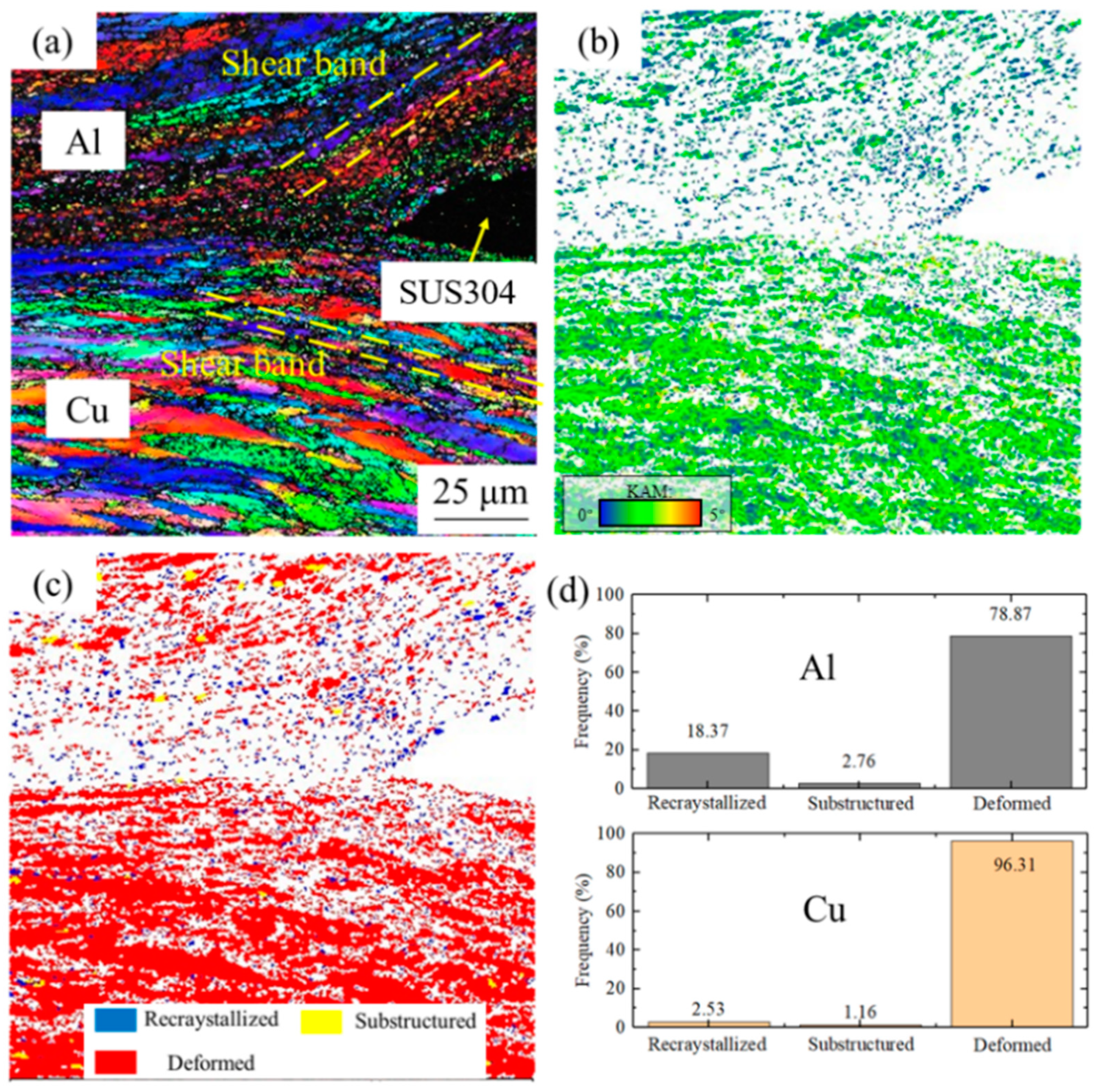
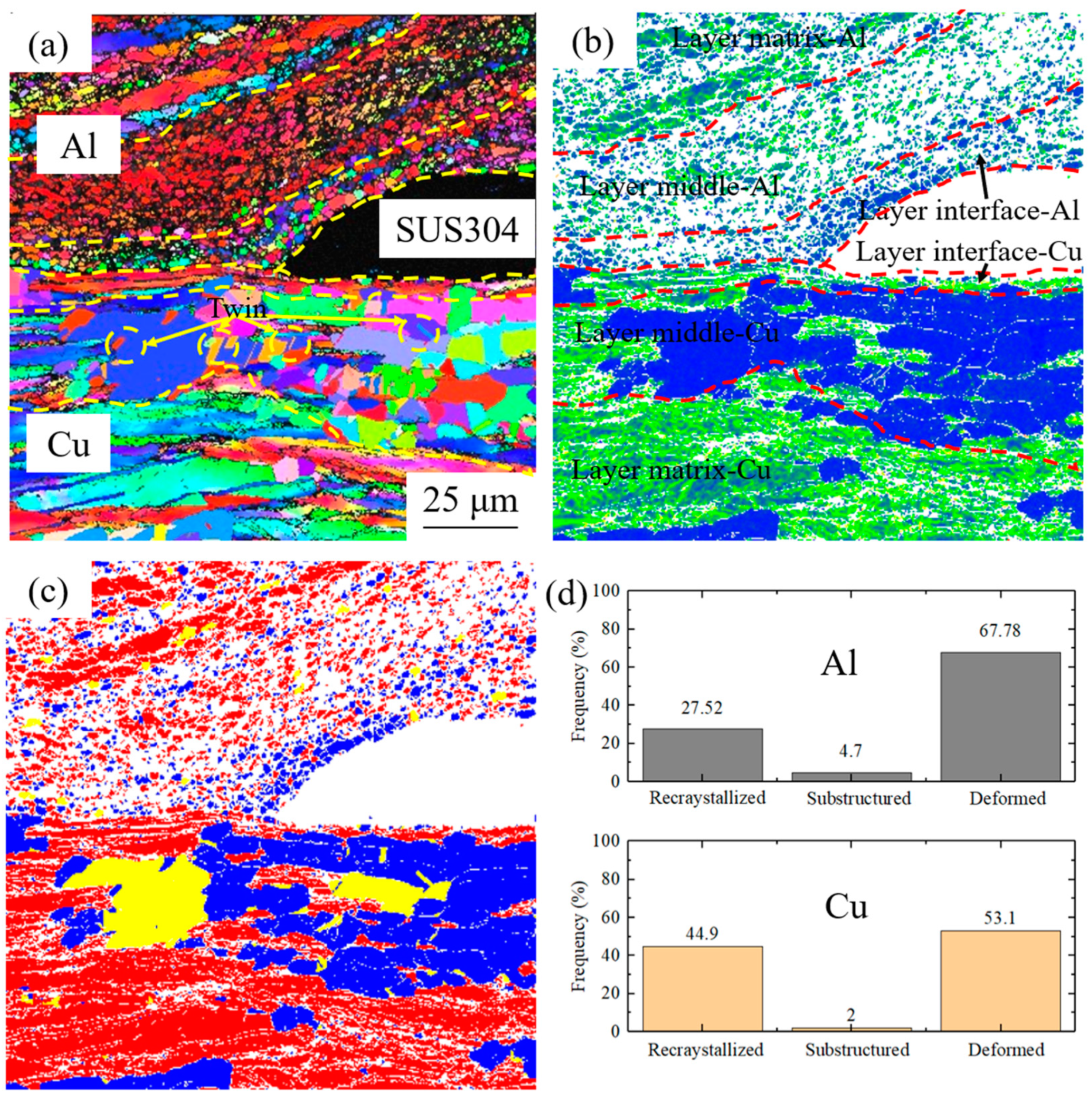

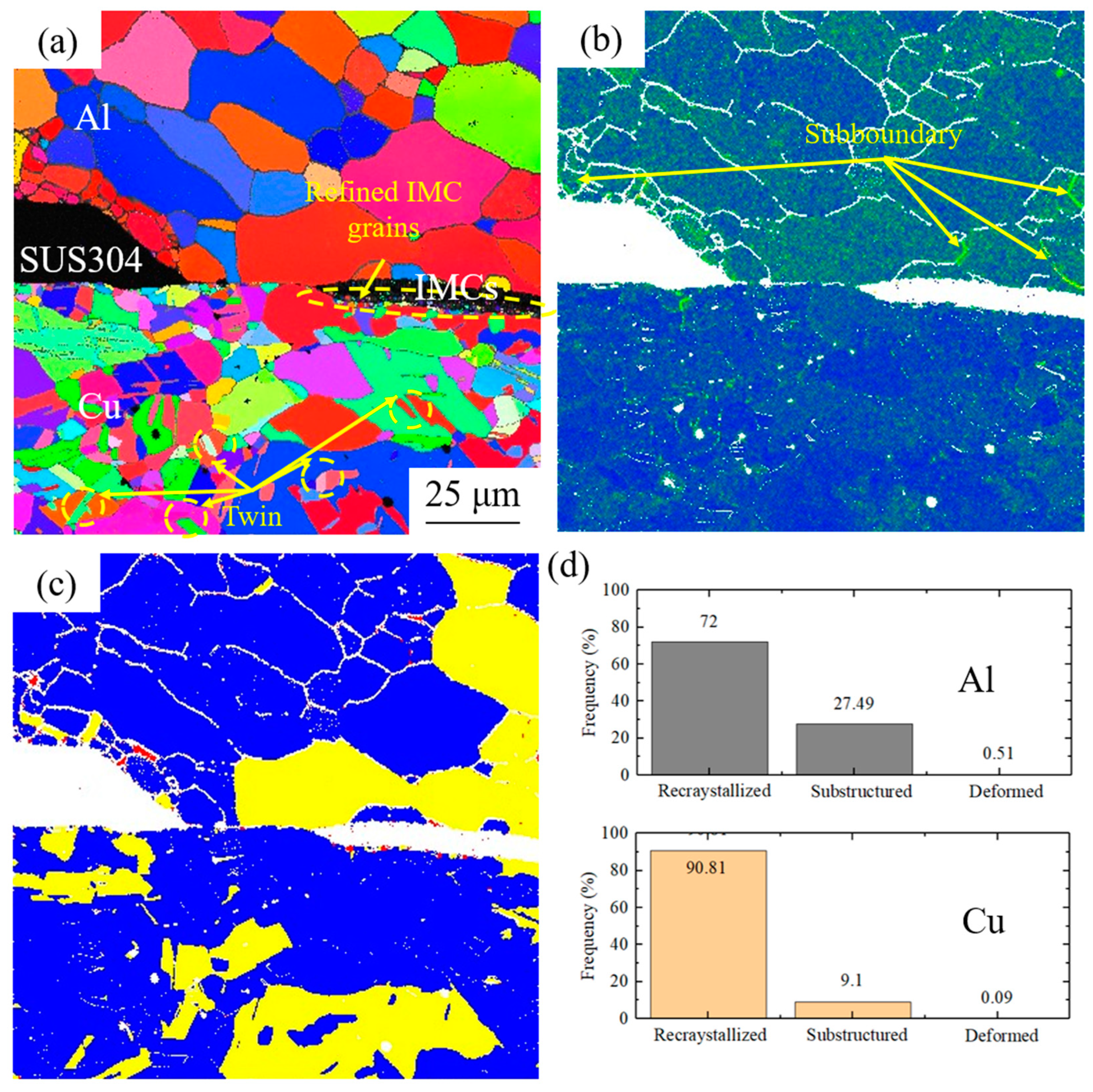
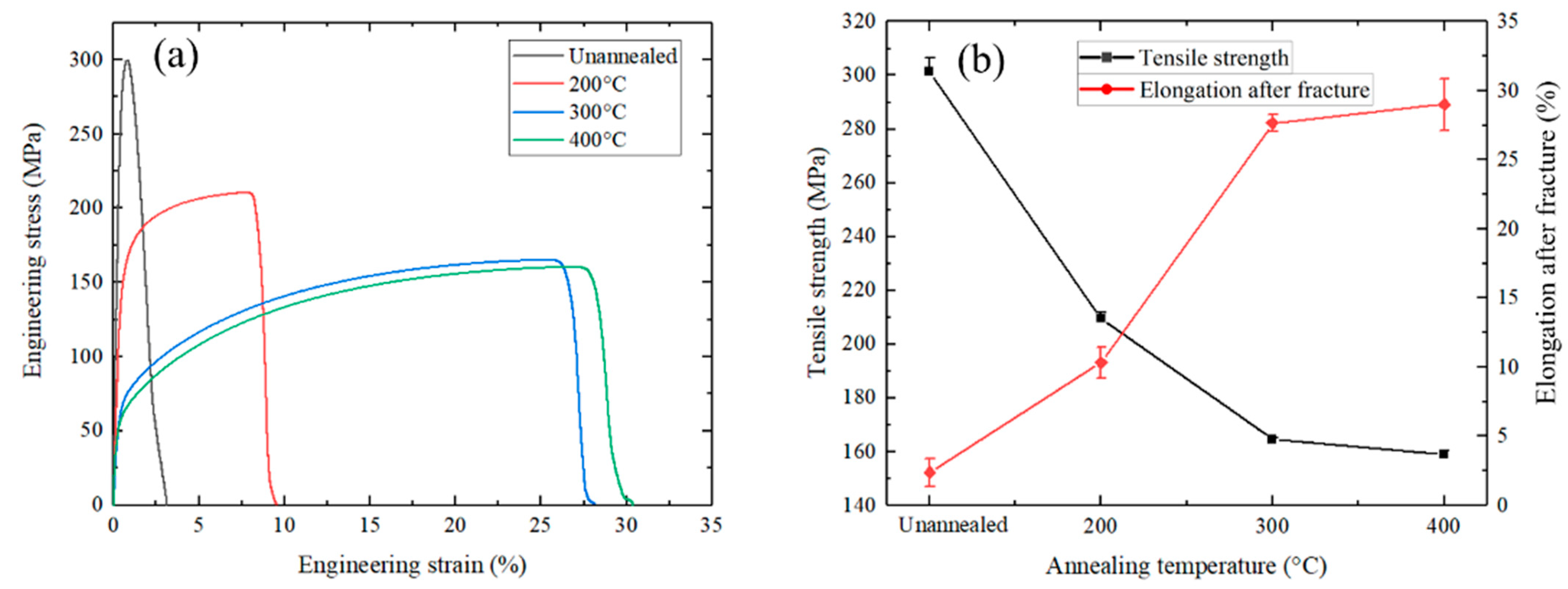
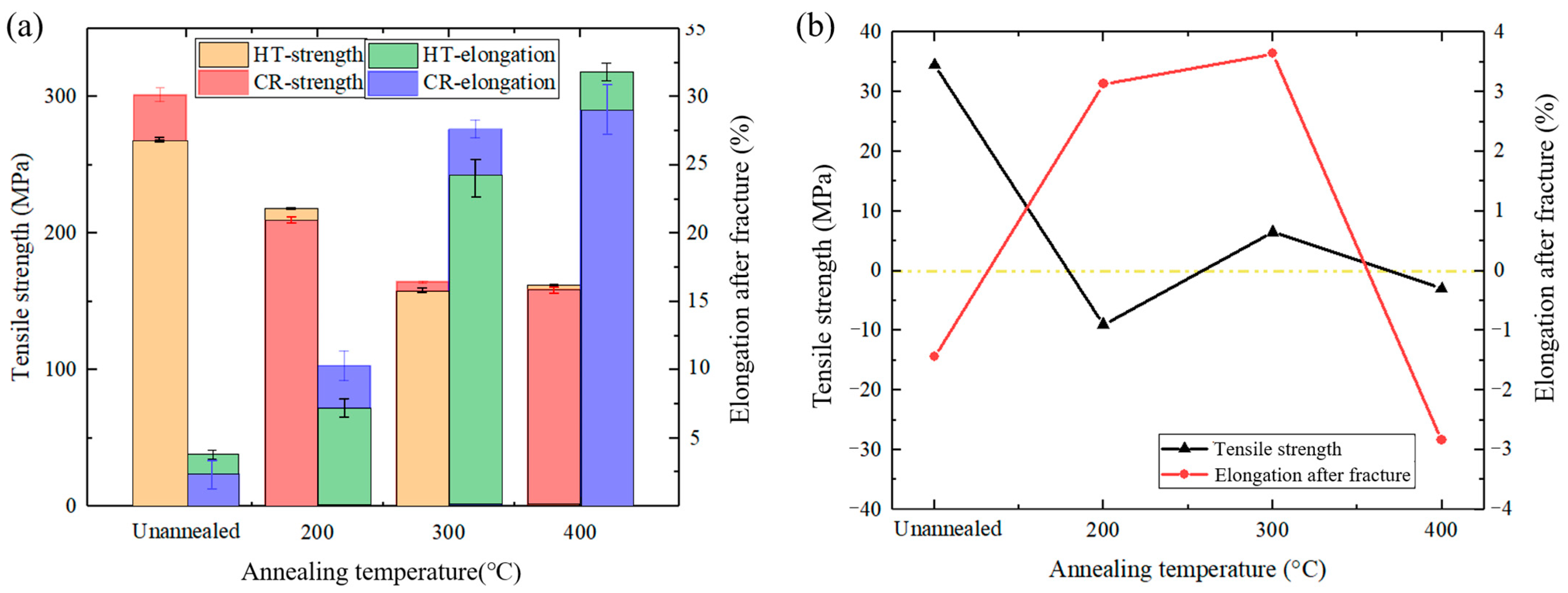
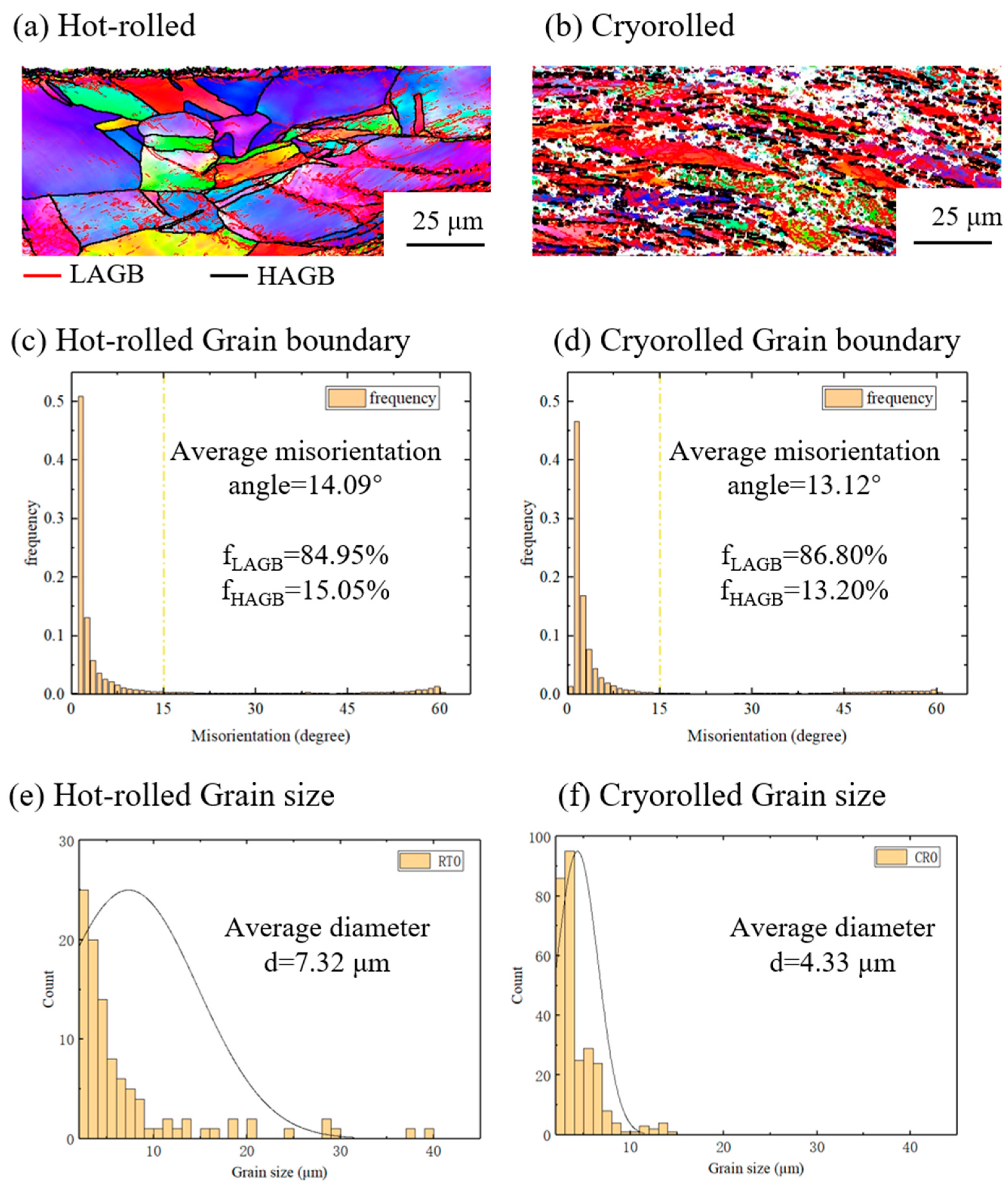
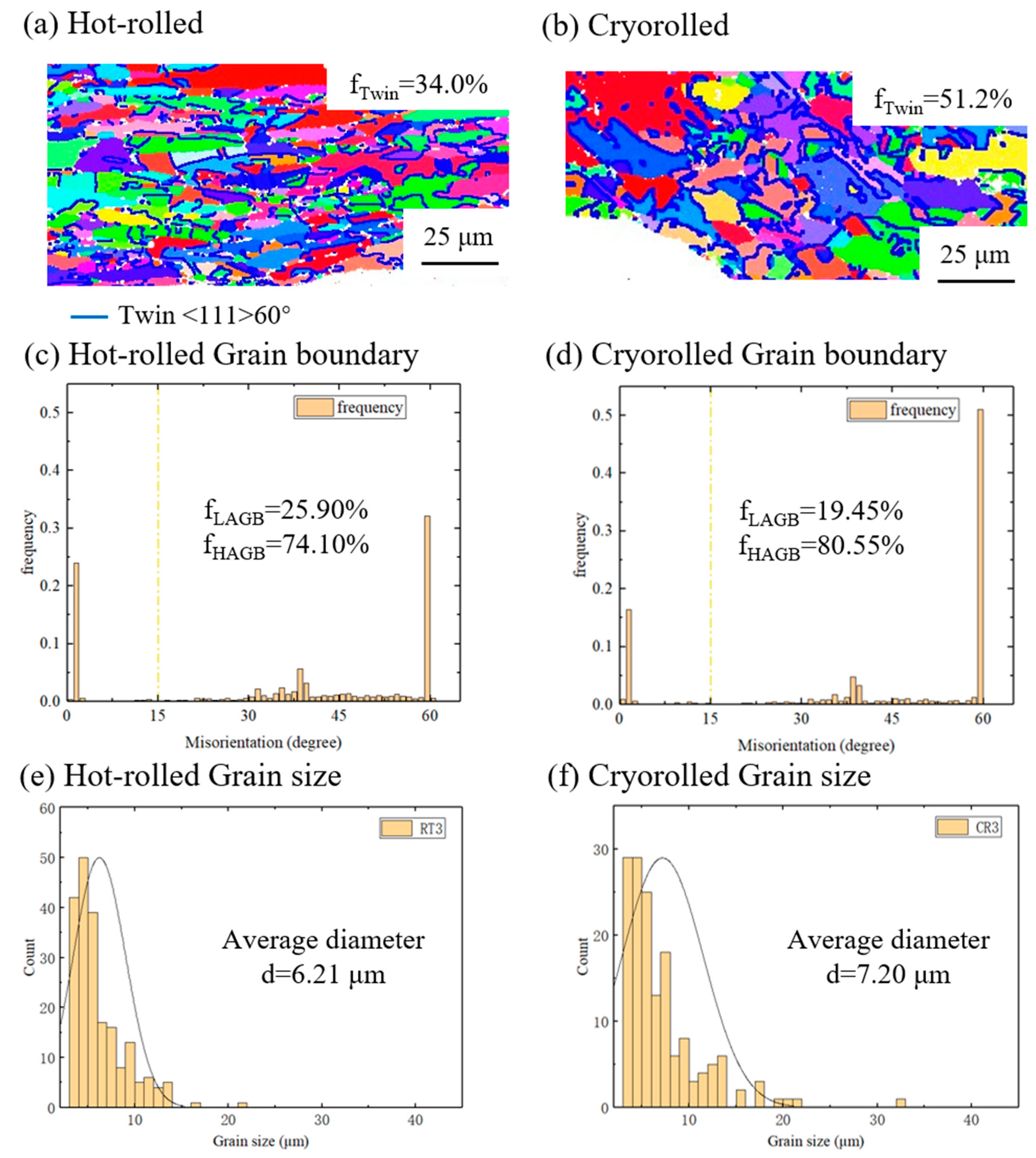
| Materials | Tensile Strength/MPa | Elongation after Fracture/% |
|---|---|---|
| T2 Cu | 205 | 46 |
| 1060 Al | 70 | 56 |
| SUS304 | 1318 | 10.2 |
Disclaimer/Publisher’s Note: The statements, opinions and data contained in all publications are solely those of the individual author(s) and contributor(s) and not of MDPI and/or the editor(s). MDPI and/or the editor(s) disclaim responsibility for any injury to people or property resulting from any ideas, methods, instructions or products referred to in the content. |
© 2024 by the authors. Licensee MDPI, Basel, Switzerland. This article is an open access article distributed under the terms and conditions of the Creative Commons Attribution (CC BY) license (https://creativecommons.org/licenses/by/4.0/).
Share and Cite
Xuan, Y.; Li, J.; Gao, H.; Yu, H. Tensile Properties of Cryorolled Cu/Al Clad Sheet with an SUS304 Interlayer after Annealing at Various Temperatures. Materials 2024, 17, 4065. https://doi.org/10.3390/ma17164065
Xuan Y, Li J, Gao H, Yu H. Tensile Properties of Cryorolled Cu/Al Clad Sheet with an SUS304 Interlayer after Annealing at Various Temperatures. Materials. 2024; 17(16):4065. https://doi.org/10.3390/ma17164065
Chicago/Turabian StyleXuan, Yanni, Jing Li, Haitao Gao, and Hailiang Yu. 2024. "Tensile Properties of Cryorolled Cu/Al Clad Sheet with an SUS304 Interlayer after Annealing at Various Temperatures" Materials 17, no. 16: 4065. https://doi.org/10.3390/ma17164065






